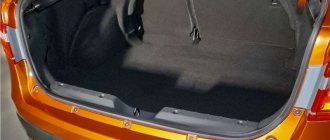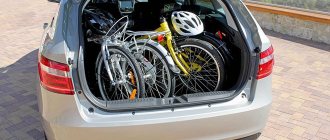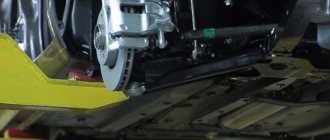It’s done - Lada has finally acquired a modern automatic transmission. Now the Xray Cross crossover has a version with a Japanese CVT and a new 113-horsepower engine. An Izvestia correspondent tested the car and found out what the new transmission brought to Lada, in addition to smooth acceleration.
Ran with Cross: AvtoVAZ showed off its muscles in Sochi
How does the new “robot” crawl, does the Xray Cross need all-wheel drive and what sporting achievements does Lada have?
Last December, Izvestia almost got a chance to drive a Lada Xray Cross with a “robot”. The prototype suddenly appeared in Sochi - there was an event for members of the jury of the TOP-5 Auto award - and also suddenly disappeared. They planned to deliver the car closed, but it was mistakenly included in the number of cars for a test drive. This created intrigue - AvtoVAZ engineers had just finalized the “robot”, and talk about the variator had not yet left the stage of rumors.
Variations on a theme
History has followed a stepless path. Moreover, the Jatco variator paired with a 113-horsepower 1.6 engine has become a universal option for automating the model range of the Renautl-Nissan and AvtoVAZ alliance. It has already been tested on Renault Kaptur, as well as on Logan and Sandero in the Stepway City version. And now it has appeared for the first time on a Lada brand car. This is just the beginning - after the Xray Cross, the Lada Vesta will receive the same engine and variator; production of such cars is planned to begin in a few months. So the first test of the CVT Lada is doubly interesting.
Lada
Dimensions of Xray Cross are 4171×1810×1645 mm, wheelbase is 2592 mm. With the installation of the CVT, the off-road geometry did not change. Ground clearance - 215 mm, approach angle - 21 degrees, approach angle - 24 degrees
Photo: LADA
Some, hearing the word “variator”, will say: fi! Among the disadvantages, they will recall boring acceleration, sensitivity to overheating, oil cleanliness and a ragged driving style. It’s funny, representatives of AvtoVAZ call the variator exclusively “automatic”, which does not contradict the truth - it is still one of the types of automatic transmissions, but at the same time it demonstrates a cautious attitude towards the real name.
Gold dust: why the bestseller was converted into a crossover
Test drive Lada Granta Cross, queen of a falling market
CVTs are popular again. Now Hyundai has started to actively use them. Their design is becoming more and more perfect, although the principle remains unchanged - the gear ratio is changed using pulley cones, between which the V-belt is sandwiched.
What is the difference between a robot (AMT), a variator and a hydraulic automatic
When discussing different types of transmissions online, the robot and CVT (more of a robot) are often referred to as fake automatic transmissions, pseudo-automatic transmissions, etc. Let us clarify in simple words.
An automatic transmission is one that does not require the driver to depress the clutch and change gears. There are two pedals, not three, like a manual one.
AMT box for Lada X-Ray
Thus, all three types are automatic. Yes, the robot is a manual transmission, which was equipped with an ECU and actuators, but after that it became automatic in its main function - to free a person from actuating the clutch and changing gears. But the technical solution to the automation problem is different.
A classic hydraulic automatic transmission (this is what is commonly called an automatic transmission) transmits torque and changes the gear ratio using a torque converter and several planetary gears.
The variator also has a torque converter that performs clutch functions. The box smoothly, steplessly changes the gear ratio using a friction mechanism. As such, there is no gear shifting.
A robotic transmission is a manual gearbox assembled with a clutch, equipped with actuators for gear shifting and clutch release, as well as an electronic control unit (ECU) and sensors.
The best Lada
In the history of Lada, this is generally the most modern automatic transmission. Before this, cars of the Russian brand were equipped either with an AMT robot with one clutch, which, despite modifications, never learned to change gears smoothly. Or an old four-speed hydromechanical “automatic” - this option is still used on the Grant.
By the way, it is not surprising that Xray Cross was the first to receive a new transmission. This is the most advanced car in the Lada model range, although it is built on the B0 platform of the cheapest Renault, Sandero and Logan. There is some irony in this, but to AvtoVAZ’s credit, the simple cart was significantly improved, and on its own. The track became wider, the steering wheel received electric power instead of hydraulic power and reach adjustment, and disc brakes appeared at the rear.
In fact, instead of an elevated version of the Xray, AvtoVAZ made a new car. Renault also decided to modernize the B0 platform, renaming it Global Access, but for now even the newest Arkana coupe-crossover comes with rear drum brakes.
For a penny of change: the very first Lada versus the newest
Test drive VAZ-2101 at Lada Vesta Cross
It seems like the Alliance has a CVT on X-Ray, but not the same
And, indeed, there are some fundamental differences from the CVTs used by the Alliance, namely, in X-Ray they install a CVT with a two-stage gearbox. Which, according to the developers, allows the unit to be, firstly, more compact and, secondly, 13 percentage points lighter than that of traditional CVTs of the Jatco family.
This design supposedly improves the car's towing capacity. However, none of the horde of developers, much less the larger gang of experts, will dare say that the variator is not afraid of cold weather, loads, and especially slipping.
In seconds and liters
The Jatco variator here is not quite ordinary - a V-belt transmission is coupled to a two-speed automatic transmission. The increasing stage allows you to save fuel at low speeds, the decreasing stage should provide dynamic acceleration. In addition, the design of the variator prevents the belt from being at the very edge or axis of the cone, where it can slip. This should improve the durability of the unit.
You expect emotional acceleration from a bright orange car, but the acceleration is not impressive. The engine's voice cannot be called sporty, and therefore it is muffled quite correctly. The Xray Cross accelerates from zero to “hundreds” in 12.3 seconds, the same amount required for a regular Xray with a 1.8 engine (122 hp) and a “robot”. The difference is in the quality of acceleration; a car with a CVT accelerates as smoothly as possible. It seems that AvtoVAZ engineers were tired of the reproaches of those dissatisfied with the twitchy “robot”, and they elevated smoothness to an absolute.
Lada
The Xray Cross with a CVT accelerates from zero to “hundreds” in 12.3 seconds. Maximum speed - 162 km/h
Photo: LADA
Casket of sports: test drive of the fastest Lada Vesta
What to expect from a sports flagship from Togliatti
The numb throttle pedal needs to be pressed slowly and smoothly to achieve a linear response. As soon as you let it go, the engine speed drops rapidly - this car is not set up to race, but to save fuel.
However, the CVT is still inferior to the “robot” in consumption; the regular Xray, even with a more powerful 122-horsepower engine, is more economical: 6.8 versus 7.1 liters on average. Judging by the stated figures, the continuously variable transmission is a little thirstier in the city and a little more economical on the highway. The on-board computer of our car showed a consumption of 9.1 liters, which is quite consistent with city figures.
Design features of the machine
In order to more clearly demonstrate the design features of the AMT, here is a photo:
The X-Ray auto transmission has a torque converter (in the photo the red arrow indicates the drive pulley of the variator on the shaft coming out of the depths of the torque converter, and the driven pulley is indicated by a green arrow). A variator and a planetary gear, which is located on the shaft of the variator driven pulley.
The planetary mechanism of this unit provides two modes of forward movement and one mode of backward movement. This design solution, firstly, reduced the size of the pulleys and, secondly, shortened the metal belt, and all this, as already mentioned, ultimately lightened the weight of the transmission.
Victim of regimes
The roads in the Kaliningrad region were mostly built by the Germans. A narrow asphalt strip is squeezed by rows of mighty trees. Local cars are not in a hurry, but the traffic is heavy and you need to overtake quickly. This is where the smooth adjustment of the variator gets in the way; a lot of time passes between the click of the kickdown button under the depressed gas pedal and the start of intense acceleration. A manual mode with fixed gears allows you to perk up the transmission, but the Xray Cross obviously lacks a sport mode.
Lada
Photo: LADA
Lady X: a girl from Togliatti has become prettier and invigorated
Test drive of the updated Lada Granta
The manual version has it as part of the Ride Select system along with two off-road modes. But the version with a variator does not have a choice of driving settings. Why? Representatives of AvtoVAZ will say that the Xray Cross with “mechanics” and “automatic” has different buyers. In fact, the reason is the torque limitation - the variator is designed only for 160 Nm, and the 1.6 engine produces 152 Nm. The Ride Select system puts too much stress on the transmission, so it was decided to abandon it for the sake of the durability of the CVT. By the way, for the same reason, this continuously variable transmission cannot be paired with the 1.8 engine, which produces 170 Nm at its peak. Although I note that Renault has paired the CVT with the turbo engines on the Renault Arkana, so within the framework of one alliance it would not be difficult to install another transmission on the Xray, if there was demand.
On the one hand, the off-road modes of the driving electronics are a sensitive loss, given that the Xray Cross does not have all-wheel drive. On the other hand, modern crossovers spend more time in the city crowd and a normal “automatic” is more important for them than increased cross-country ability.
How to ride without steps
However, the Xray Cross is also capable of off-road feats - the installation of a CVT did not affect the ground clearance; here it is still 215 mm. Suspension settings allow you to take on obstacles while moving. The torque converter will protect the continuously variable transmission from jerking when driving over uneven surfaces and will help you climb steep hills.
Lada
Photo: LADA
AvtoVAZ has released a new version of the Lada Granta with sports suspension
Since the Japanese 1.6 engine is aluminum and lightweight, the Xray Cross with it and the CVT turned out to be not much heavier than the version with the Russian 1.8 engine and “mechanics”. So the suspension settings have not been changed, and it still pleases with good energy consumption.
However, on the asphalt it seemed to me that the steering wheel was not as clear in the near-zero zone as in a car with a manual transmission. Although with increasing speed this disadvantage disappears. And the Xray Cross is devoid of slips during acceleration typical of front-wheel drive cars - the wheel drives here are of the same length.
Lada Xray Cross with a CVT has passed a full cycle of southern, northern and mountain tests from Siberia to the Caucasus. The minimum mileage of each car was 160 thousand km, which is one and a half times more than the warranty mileage.
lada1
17-inch alloy wheels are available as standard
Photo: LADA
lada1
The steering wheel is adjustable for reach. Starting from the Luxe version, it is trimmed in leather
Photo: LADA
lada1
The interior can be trimmed with orange inserts
Photo: LADA
lada1
The new multimedia system supports iOS and Android devices
Photo: LADA
lada1
You can call the voice assistant using the button on the steering wheel
Photo: LADA
lada1
The cruise control button is located in an unusual place, on the left of the panel
Photo: LADA
Lada
In addition to the heated steering wheel and seats, the Xray Cross has a heated windshield
Photo: LADA
Lada
There is only one USB socket in the back row
Photo: LADA
Lada
Tall passengers will like the back row of the Cross version more - here you can put your feet under the front seats
Photo: LADA
Lada
With the seats folded down, trunk volume increases from 361 to 1,514 liters. The folding backrest of the front passenger seat allows you to transport long items
Photo: LADA
Lada
The same 1.6 engine was previously installed on the regular Xray and developed 110 hp. For economic reasons, it was replaced with a Russian unit with a capacity of 106 hp.
Photo: LADA
AvtoVAZ will release Lada Vesta with a CVT
Representatives of AvtoVAZ claim that the oil in the variator is designed for the entire period of operation. Maintenance comes down to monitoring the oil level using a dipstick. Although for Renaults with the same transmission it is recommended to change the oil every 70 thousand. In any case, if treated with care, the service life of the variator is comparable to that of a classic automatic transmission.
The crunch of a Japanese bun: the first test drive of the Lada Xray Cross with a CVT
I remember that the Lada Xray - even without any Cross prefix - was already launched in Russia with the French H4M engine with a volume of 1.6 liters. The unit turned out to be too expensive: at the beginning of 2016, it was just being assembled in Togliatti, localization was shallow, and some parts had to be delivered from abroad by plane. According to the permanent head of the Xray project, Oleg Grunenkov, “it was a disaster.” Over time, Tolyatti introduced head and block casting with subsequent machining, began to produce crankshafts, and at the same time replaced import suppliers for some components. As a result, the unit not only became competitive in price, but also made it possible to avoid unnecessary costs when “automating” the Lada Xray Cross.
1 / 4
2 / 4
3 / 4
4 / 4
Let us remember that the block of modern Togliatti engines is cast iron, and the 1.8-liter VAZ-21179 is no exception. Therefore, the French-Japanese power unit turned out to be heavier than the 1.8 + 5MT pair by only 13 kg, despite the fact that the variator itself weighs 71 kg. This allowed the engineers to make do with the Lada Xray with the very significant modifications to the chassis that they carried out when preparing the Cross version, which we wrote about in detail in the material devoted to the first test of the Zhiguli new product.
Meanwhile, it is the presence of a borrowed power unit from the Renault and Nissan models that determines the impossibility of transferring to other modifications of the Xray such a useful unit as the intermediate support for the drive shaft of the right front wheel, which makes it possible to install identical driveshafts with joints of equal angular velocities on both sides. Nobody will adapt the design to ordinary VAZ engines - it’s expensive. On the other hand, the Lada buyer is not demanding in terms of handling or, say, course stability during emergency braking. To be fair, on the Xray, different shaft lengths have less of an impact on the car's ability to stay straight when decelerating. But try to brake hard on the Grant: the car will “carry” from side to side, and the driver will not be able to do without correcting the trajectory with the steering wheel. The exhaust system that goes to the H4M engine is again not transferable to the “native” units, but it gives the best performance in terms of noise and vibration.
Meanwhile, the CVT itself, without a doubt, adds noise to the cabin. At least the low metallic sound from the movement of the set-up belt along the pulleys is very clearly audible in the cabin, and the more intense the acceleration, the higher its component.
The combination of a CVT with VAZ engines 21129 and 21179 is not provided. Structurally, there are no obstacles to this, although the variator cannot handle the torque of the 1.8-liter engine. On the other hand, the CVT version of the Xray Cross will not receive the Ride Select system, or, more simply put, a puck with a set of transmission mode settings that are more needed on the version with a “handle”. Hand on heart, this only causes one inconvenience for the owner of the Xray Cross CVT: the button to turn off the stabilization system is not on the washer located on the central panel, but on the tunnel under the handbrake - remember where the window lifters were located on the first Logan? So the right button is now dedicated to disabling ESP, and on the left side there is just a plug. This was a decision of the alliance, as well as the use of CVT by AvtoVAZ on B- and C-class models. In this sense, it is already clear that the upcoming compact crossover Lada, which is now being actively “thought about” in Tolyatti, will have CVT, but the next new product with a CVT will be Vesta. True, if earlier they strictly promised to present it to journalists before the new year 2022, now they say: “we will show it in the next few months.”
Let us recall that in the JF015E variator, to eliminate belt travel in the “border” zones - on the edge of the pulleys and at a small radius - there is a two-stage planetary gearbox, which, during smooth acceleration, switches to a higher stage at speeds from 40 to 60 km/h, but can also go back if the driver decides to push the gas all the way “to the button”, or, more simply put, play kickdown. As for the torque converter, it is excluded from operation, that is, it is blocked already at speeds of 10–15 km/h, but it will play a positive role off-road. So, blocking the “donut”, switching in the planetary gear when moving forward and reverse: the clutches will regularly supply the oil with friction products, but it will not be possible to change the ATF preventively - it is filled for the entire warranty period, so you will have to wait up to 100,000 km.
What about off-road? After all, Xray Cross seems to be bought in part in order to feel more free off the asphalt... On the one hand, the presence of a torque converter is always a plus, the wheels will not slip. On the other hand, the H4M is still not just weaker than our 21179, and its peak torque (152 Nm versus 170) occurs at 4,000 rpm versus 3,700 for the Tolyatti unit.
1 / 4
2 / 4
3 / 4
4 / 4
Let's see what's on our wheel. It turns out that the moment is almost the same. Both with a manual transmission with a 1.8 engine and with a variator, the transmission increases it by more than 15 times, while the CVT version also retains a torque converter that adds its own gear ratio: when driving along gullies at low speeds, the “donut” remains open. This covers the difference in the traction capabilities of the engines, but all these considerations are still “on paper”; we have not yet gone into the fields with an automatic Xray Cross.
Let us remember that even on a 1.8 engine with a clutch driven disc increased from 200 to 215 mm, there is still a danger of burning it in the fields, so a “donut” can be useful. On the other hand, both engines, especially the “French” one, frankly speaking, are not very suitable for adventures off the asphalt, but you can drive on muddy dirt roads and the easiest “crossroads”, the main thing is not to forget to switch to manual mode and control the transmission in the first programmed stage , corresponding to the lowest gear ratio provided by the pulleys.
1 / 4
2 / 4
3 / 4
4 / 4
Another very interesting point. When installing a variator, the Togliatti residents kept the ground clearance of the Xray Cross at 215 mm, while their colleagues from Renault refused to install a CVT on the Logan Stepway City version: the variator crankcase is larger than that of a manual box, and in the “French” it ate up several precious millimeters of ground clearance due to the fact that the subframe has to be installed lower. There are no such problems on the Xray: it seems that even during the development of the car, the possibility of placing this Japanese “automatic” under the hood was provided. By the way, the mounting points for the power unit on the Xray Cross are the same as on the 1.8 5MT, but the supports themselves are of a different design. Again, let’s add that, unlike many “Chinese” cars, with the advent of the CVT, the Xray Cross did not lose the ability to tow a trailer: it is allowed to drag an “additional” weight of 650 kg or 800 kg, depending on the presence of brakes.
Lada Xray Cross AT
1.6 Н4М CVT JF015E
113 l. With. at 5500 rpm, 152 Nm at 4000 rpm
Let's return to the features of the variator in motion. In addition to noise, another complaint was the difficult dosing of traction in city modes: if the engine immediately responds to changes in the throttle position, the components of the variator pulleys change their position with a delay, as a result, even at speeds of 50–80 km/h it is difficult to maneuver in city traffic. Oleg Grunenkov claims that an international team of Russian, French and Japanese engineers, calibrating the algorithms of the power unit, did everything to tune the car for a comfortable ride. This is necessary for those buyers for whom the Xray Cross will be the first car - they are primarily focused on them.
Maybe it would make sense to add a Sport button to the Xray Cross CVT in the future? It is quite likely that this will happen - we know that in Togliatti they react to the comments of journalists and owners. Let's not forget that next to the ESP disable button there is a “plug” that can be used for these purposes. Meanwhile, the difference in the possibilities of dosing traction with a pair of 1.8 5MT is very noticeable, and on the highway it becomes even more noticeable. Moreover, for overtaking on the highway, AvtoVAZ developers definitely recommend using manual mode, and we are convinced that you can’t do without it.
1 / 6
2 / 6
3 / 6
4 / 6
5 / 6
6 / 6
With all this, the “adjusters” left the car with good braking capabilities using programmed stages, of which there are six in the variator: switching from second to first occurs at a speed of 50 km/h, and the car effectively slows down. Meanwhile, there is no point in using manual mode when picking up speed, although here the electronics still reach the red zone of 6000 rpm faster, while in automatic mode it can hit a thousand earlier - the main thing is that the gas pedal is pressed all the way. After reaching the cutoff, the needle drops to 4500 rpm and continues to dangle between this value and the beginning of the red zone, depending on the throttle position. In manual mode, when the gas is released, the electronics hold the average speed a little better, while in the automatic mode they immediately drop by 2000 rpm and, if the driver does not accelerate, drop to idle.
In short, in terms of the sum of consumer indicators, the lack of prospects for combining a CVT with a 1.8 engine and the obvious focus of the “automatic” version on the urban girl audience, we remain in the same position: the domestic VAZ-21179 engine, coupled with a French manual gearbox, remains the best and the most capable powertrain on the Xray.
1 / 5
2 / 5
3 / 5
4 / 5
5 / 5
By the way, during the test, especially when driving in the city, I had a strong feeling that the developers somewhat reconfigured the steering wheel, trying to remove the natural “heaviness” of the mechanism. At the same time, a somewhat blurred zone with completely indistinct reactions was formed near the neutral position. Tolyatti residents claim that they have not made any changes in this regard, but quite recently our editorial team tested an Xray Cross with a 1.8 engine, and here my memory hardly fails me.
Lada Xray Cross AT
1.6 Н4М CVT JF015E
from 846,000 rubles
Finally, let’s clarify the issue of the appearance of a six-speed manual transmission on the Xray and other Ladas: it will not be there. The fact is that the JR5 family does not provide for the presence of a sixth stage at all in any form or with any upgrades. The “higher” line TL4/TL8, which goes to, say, the Duster, is a bit expensive, and in Russia, unlike the same JR5, is not localized. As for the all-wheel drive Xray, we repeat once again: this is a closed question. Two years ago, the Togliatti team not only calculated the economics of this project, but even carried out assembly work with the clutch from Duster: the clutch fits on the Xray, but the economics do not add up.
Survey
Which box is best for Lada Xray?
Your voice
Total votes:











